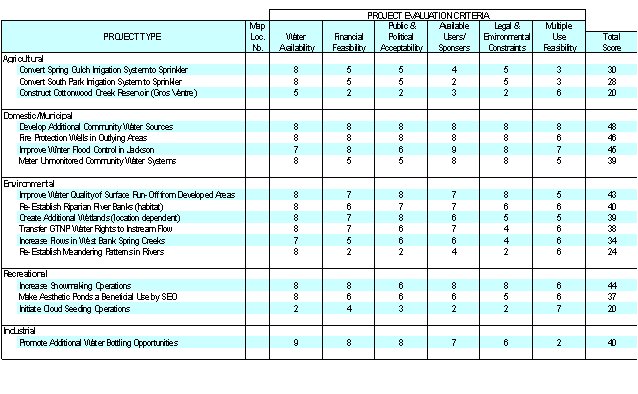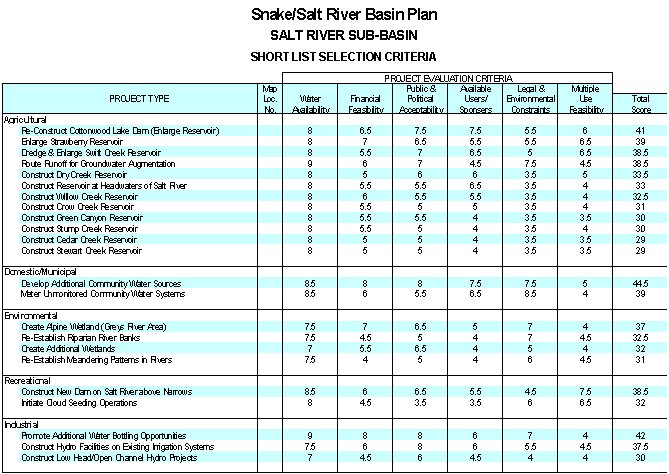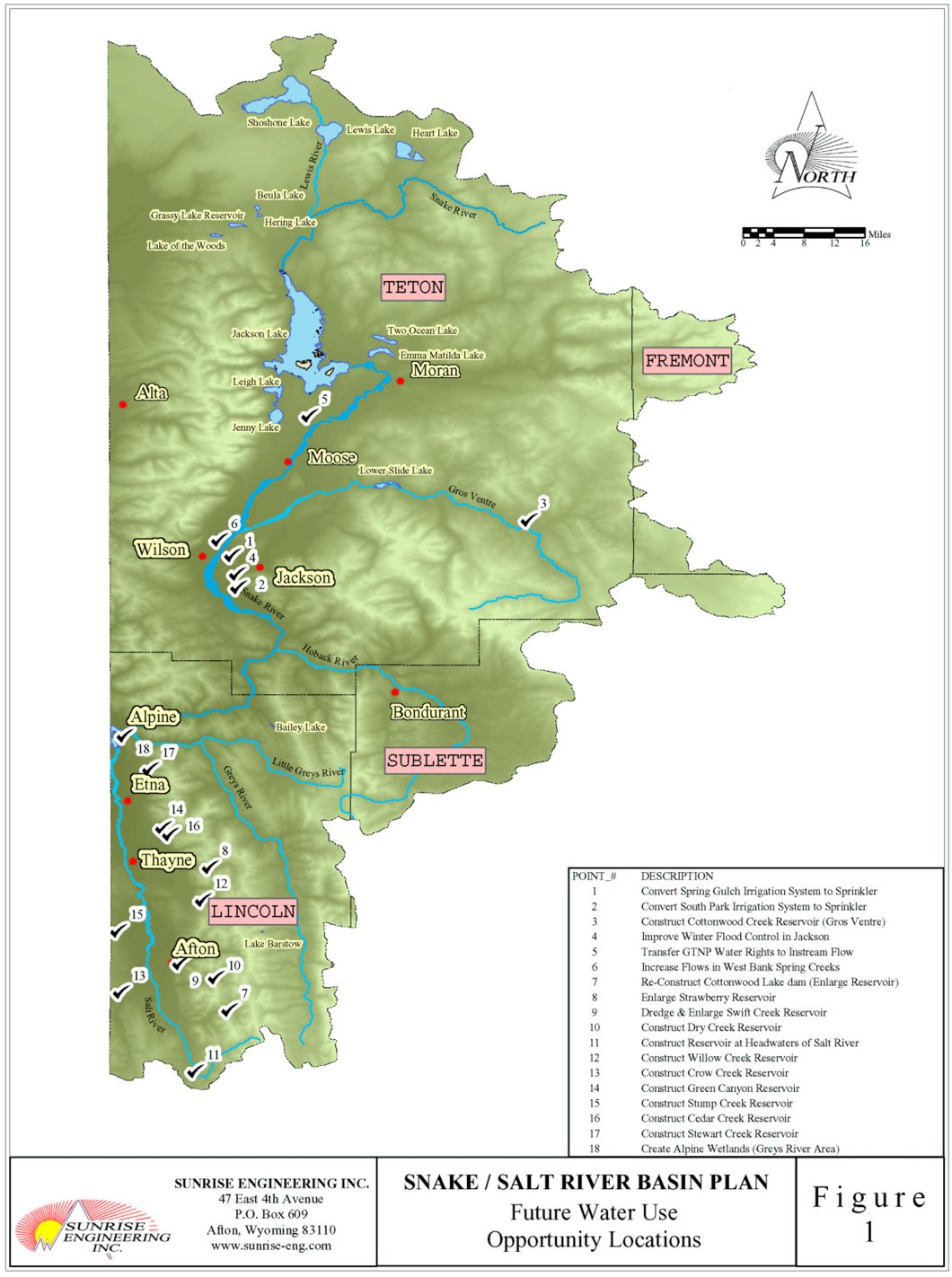Wyoming State Water Plan
Wyoming State Water Plan
Wyoming Water Development Office
6920 Yellowtail Rd
Cheyenne, WY 82002
Phone: 307-777-7626

Wyoming Water Development Office
6920 Yellowtail Rd
Cheyenne, WY 82002
Phone: 307-777-7626



TECHNICAL MEMORANDUM
| SUBJECT: | Snake/Salt River Basin Plan Future Water Use Opportunities |
| PREPARED BY: | Sunrise Engineering, Inc. |
| DATE: | November 7, 2002 |
Introduction:
This technical memorandum discusses the procedures used to create a list of potential future projects that would utilize the water resources in the Snake/Salt River basin. This list represents the needs and desires of those in the basin, and provides a starting point for additional beneficial uses in the future. A long list of potential projects was first developed with input from the Basin Advisory Group (BAG), along with a review of existing studies. This list was then reduced and evaluated with respect to various criteria, resulting in a short list of potential projects which can be compared to one another within a given use category.
Long List of Future Water Use Opportunities:
The long list of future water use opportunities was created during a facilitated session at the BAG meeting held in Moran on August 14, 2002. At this meeting, input was collected from various BAG members as well as others in attendance. Any and all input was welcome, and a wide variety of issues was discussed for possible inclusion to the list. Past studies were reviewed and similarly discussed. The long list of future water use opportunities put together at that meeting contained projects for uses such as irrigation, hydropower, wetlands, water storage, recreation, and others. In general, this list addresses the water resource related needs and desires of those in the basin with possible solutions.
While input during the BAG meeting was exceptional, there were many BAG members who were not in attendance. It was determined that the resulting long list should be distributed to the entire Basin Advisory Group in order to give everyone a chance to comment. The list was distributed via email on August 26, 2002, with a request for each BAG member to review the items and provide additions or comments. Some additional input was received following the email distribution. The resulting long list is shown in Appendix A. Additional information about each of the proposed opportunities can be found in Appendix B.
Short List of Future Water Use Opportunities:
Following the creation of the long list and collection of BAG member input, the resulting list was reviewed in order to reduce the list to a collection of potentially feasible water use opportunities. Some items on the long list, while they may be worthy of further discussion in other circles, did not warrant further investigation as part of this basin plan. This was generally for items that could only be addressed by specific state agencies, and included reciprocal fishing licenses between Idaho and Wyoming, and septic tank management. The item regarding general support of local conservation district projects was dropped, as there was not a specific project to be included at this time. Also, projects that appeared to have a low probability of support or feasibility were dropped, which included beaver management, terracing at high elevations, and trans-basin water diversions.
The short list of future water use opportunities for the Snake/Salt River basin consists of the remaining projects from the long list. These short listed projects were then reviewed by the basin planning team and evaluated based on criteria derived through the statewide basin planning process. The location of these projects can be seen on Figure 1.
Short List Criteria:
The following criteria were used to evaluate the short list of future water use opportunities. Each item was scored on a scale of 1 to 10, with 1 being not feasible and 10 being very feasible.
This criterion looks at whether the project will be physically possible. Existing water rights and stream flows are evaluated, as are any other sources of water that may be involved.
This criterion looks at the general cost of the project, and if the resulting improvements will be adequate to justify repayment. The financial stability of potential sponsors is also included, and their ability to ensure sufficient cash flow. It is also realized that a project that is technically difficult will likely have a higher construction cost.
This criterion evaluates potential project sponsors, and if they are willing to spearhead and support the given project. Also, the number of beneficiaries is looked at to help quantify the positive impact the project will have.
This criterion looks at items such as state and federal laws, interstate compacts, and court decrees that could influence the feasibility of the project. The Clean Water Act, National Environmental Policy Act, Endangered Species Act, and other environmental laws are also reviewed with respect to the project. These items are particularly important if the project is located on federally managed lands.
This criteria looks at potential multiple uses of a given project. Generally, a higher score would be given for a project with more than one use. However, multiple uses may mean additional work regarding permitting.
Following the evaluation of each project on the short list using the previously described criteria, the scores for each criteria were added together to result in a final number or score. Each criteria has the same scale of 1 to 10, meaning that all criteria had equal weight in the final score. It must be emphasized that the projects were evaluated with respect to other like projects. For example, an agricultural project regarding irrigation cannot be compared to an environmental project regarding wetlands. Also, the Short List was broken into sub-basins, as issues that can effect the evaluation of a project in the Snake River basin will be different than those in the Salt River basin. The results of this evaluation are located in Appendix C. It must be mentioned that evaluation of the Short List is very subjective, and evaluation by those with differing backgrounds would likely produce a variety of results. Also, it is anticipated that the evaluation of projects will change over time as individual criterion within a project could also change, due to social, political, and economic influences. The final scores do not have any bearing as to what projects will or will not be pursued in the future. They only provide a subjective relative ranking, and do not delineate which project is most important or favored.
References:
States West Water Resources, Water Conservation, Technical Memorandum, Green River Basin Plan, 2000.
Wyoming State Engineer’s Office, Wyoming Water Planning Program, Report No. 12, Water & Related Land Resources of the Snake River Basin, Wyoming, December 1972.
APPENDIX A
Long List of Future Water Use Opportunities
LONG LIST OF FUTURE WATER USE OPPORTUNITIES FOR THE
SNAKE/SALT RIVER BASIN
Long list of possible water use opportunities as derived through the basin planning process:
LINCOLN COUNTY AREA PROJECTS
TETON COUNTY AREA PROJECTS
BASIN WIDE PROJECTS
*PROJECTS FROM “WATER & RELATED LAND RESOURCES OF THE SNAKE RIVER BASIN, WYOMING”, 1972.
APPENDIX B
Long List of Future Water Use Opportunities Descriptions
LONG LIST OF FUTURE WATER USE OPPORTUNITIES FOR THE
SNAKE/SALT RIVER BASIN – PROJECT DESCRIPTIONS
LINCOLN COUNTY AREA PROJECTS
TETON COUNTY AREA PROJECTS
BASIN WIDE PROJECTS
*Projects from “Water & Related Land Resources of the Snake River Basin, Wyoming”, 1972.
APPENDIX C
Short List of Future Water Use Opportunities
Snake/Salt River Basin Plan
Snake River Sub-Basin
Short List Selection Criteria


Figure 1
Future Water Use Opportunity Locations
